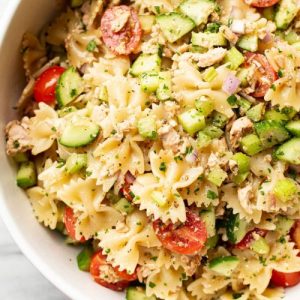
Tuna Pasta Salad
A fresh, protein-rich tuna pasta salad loaded with crisp vegetables and tossed in a light olive oil and balsamic dressing. Perfect for quick lunches, meal prep, or summer gatherings, this salad is flavorful, filling, and easy to make.
Equipment
- 1 Large Pot – for boiling pasta
- 1 large mixing bowl
- 1 knife
- 1 Cutting board
- Measuring cups and spoons
Ingredients
- 3 cups uncooked pasta bow-tie or your choice
- 6 oz canned tuna drained
- 2 tbsp red onion finely chopped
- 1 cup cherry or grape tomatoes halved
- 2 stalks celery finely chopped
- 1 mini cucumber or ¼ English cucumber diced
- 1 tbsp fresh parsley chopped
- 1 tbsp balsamic vinegar
- 2 tbsp olive oil
- Salt and pepper to taste
Instructions
- Prepare the Pasta: Fill a large pot with water and add a generous pinch of salt to season the pasta while it cooks. Bring the water to a rolling boil over high heat. Once boiling, carefully add 3 cups of uncooked pasta, such as bow-tie or macaroni, and stir gently to prevent sticking. Cook the pasta until it reaches al dente—tender but still firm to the bite—following the package instructions, usually around 8–10 minutes. Stir occasionally to ensure even cooking. Once done, drain the pasta in a colander and immediately rinse it under cold running water. This stops the cooking process, cools it for salad use, and prevents the pasta from becoming mushy. Let the pasta drain completely to remove excess water.
- Prep the Vegetables: While the pasta is cooking, focus on preparing the fresh vegetables. Start by finely chopping 2 tablespoons of red onion and 2 stalks of celery into small, bite-sized pieces. Slice 1 mini cucumber (or ¼ English cucumber) into small cubes. Cut 1 cup of cherry or grape tomatoes in half for a burst of color and freshness. Chop 1 tablespoon of fresh parsley finely. Combining these vegetables early ensures they are evenly distributed throughout the salad, giving every bite a mix of flavor and crunch.
- Combine the Protein: Open a 6-ounce can of tuna and drain it thoroughly to remove any excess liquid. Transfer the tuna into a large mixing bowl. Use a fork to gently break apart the chunks, keeping some texture for a satisfying bite. Tuna provides a high-protein base for the salad, making it filling and nutritious while pairing beautifully with fresh vegetables.
- Mix the Salad Base: Add all the prepared vegetables—onions, celery, cucumber, tomatoes, and parsley—into the same large bowl as the tuna. Gently toss them together with a spatula or large spoon, ensuring that the ingredients are evenly distributed. This creates a colorful and balanced salad base that will complement the pasta once added.
- Add the Pasta: Carefully add the cooled and drained pasta to the mixing bowl with the tuna and vegetables. Fold the pasta into the mixture slowly to avoid breaking the noodles. Make sure the pasta is evenly coated with the salad ingredients, ensuring each bite has a combination of tuna, vegetables, and pasta.
- Dress the Salad: Drizzle 1 tablespoon of balsamic vinegar and 2 tablespoons of olive oil over the pasta mixture. Use a spoon or spatula to gently toss everything together until the salad is evenly dressed. Taste the salad and season with salt and freshly ground black pepper to your preference. For extra flavor, you can adjust the olive oil or vinegar slightly, adding more to your liking.
- Chill or Serve Immediately: The salad can be served immediately for a fresh, quick meal, or it can be covered and chilled in the refrigerator for 30–60 minutes.Chilling allows the flavors to meld together, enhancing the taste of the vegetables, tuna, and dressing. This makes it perfect for make-ahead lunches, meal prep, or potluck gatherings.
- Garnish and Enjoy: Before serving, give the salad a gentle toss to redistribute any dressing that may have settled. Optionally, sprinkle extra chopped parsley on top for color and freshness. in individual bowls or on a large platter for sharing. Enjoy your protein-packed, fiber-rich, and light tuna pasta salad as a nutritious lunch, side dish, or picnic favorite.
Notes
- Adjust pasta quantity: If using macaroni instead of bow-tie pasta, reduce uncooked pasta to 2.5 cups to maintain salad balance.
- Customize vegetables: Feel free to add or swap veggies like bell peppers, corn, or shredded carrots to suit your taste.
- Dressing flexibility: Add more olive oil or balsamic vinegar for a richer or tangier flavor.
- Make ahead friendly: This salad tastes even better after sitting in the fridge for 30–60 minutes.
- Protein boost: Add boiled eggs, chickpeas, or shredded chicken to increase protein content if desired.